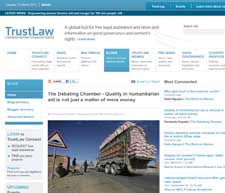March 12, 2012
Source: TrustLaw
Fernando Espada is field research manager of DARA‘s Humanitarian Response Index. DARA is an independent organisation committed to improving the quality and effectiveness of aid for vulnerable populations suffering from conflict, disasters and climate change. The opinions expressed are DARA’s.
The humanitarian sector is used to dealing with crisis situations, which usually implies making the most of what they have in difficult contexts.
And what they have comes — with few well-known exceptions like Doctors without Borders — from government donations, mainly Western countries. The same countries that are living one of the worst financial crisis in recent history with no end in sight.
Western governments are in the process of controlling their deficits by downsizing expenses, including humanitarian aid budgets.
Beyond the fact that reducing the already small humanitarian budgets is not the most sensible measure one can imagine, this decision has already been taken, so the humanitarian sector better find ways to keep working in this new scenario.
And this includes government aid agencies. It wouldn’t be fair for government aid agencies to simply pass the burden to United Nations (U.N.) agencies and non-governmental organisations (NGOs) while expecting them to do the same with less money.
Five years of research for the new Humanitarian Response Index have helped us understand that donor governments do not always make the best use of their humanitarian budgets.
For example, the politicisation of aid, a worrying trend we saw in several crises such as Somalia, dramatically reduces the ability of implementing agencies to operate, increasing inefficiencies and gaps in the response.
Nevertheless, bad practices should be avoided at any time, both during a financial crisis or prosperity. Now the challenge for donor governments, no matter their size or budget, is to change aspects of their policies and practices by taking simple cost-neutral steps that would substantially increase the effectiveness of its donor-power.
We offer some ideas:
Shift greater funding to support preparedness, risk mitigation and prevention activities to reduce current vulnerabilities and avert future crises. Most of the crises included in the 2012 humanitarian appeal were predictable and half of them have been among the top humanitarian aid recipients over the last decade. Investing in strengthening community resilience, prevention, preparedness and risk reduction is not only wiser but also cheaper than funding emergencies like the 2011 famine in the Horn of Africa in when it is already too late.
Improve transparency and consistency of donor reporting. This is not just a matter of bureaucratic procedures, but it would allow all donors to align their funding to needs that have not been funded sufficiently by others. Moreover, consistent reporting requirements will help humanitarian organisations to reduce administrative workload and concentrate on field work.
Engage more regularly with field partners to stay up-to-date with the situation in different crises, seeing if they require support, or to ensure compliance with requirements, such as beneficiary participation and accountability toward beneficiaries. For that, donors don’t necessarily need a permanent presence in the field. Regular phone calls or emails may be enough to keep the contact with partner organisations in the field.
Requiring partners to disaggregate data by sex and age in needs assessments and reporting as a first step to ensure the needs of women, men boys and girls are taken into account in humanitarian programmes. Without an accurate knowledge of who are the people they are trying to help, donors can’t expect to maximise the impact of their humanitarian funding.
Blaming donor governments for reducing aid budgets may be fair, but reminding them that quality in humanitarian aid doesn’t depend on spending more money would certainly be more efficient.

Share this